Sizing Up Servers: Intel's Skylake-SP Xeon versus AMD's EPYC 7000 - The Server CPU Battle of the Decade?
by Johan De Gelas & Ian Cutress on July 11, 2017 12:15 PM EST- Posted in
- CPUs
- AMD
- Intel
- Xeon
- Enterprise
- Skylake
- Zen
- Naples
- Skylake-SP
- EPYC
Intel Expanding the Chipset: 10 Gigabit Ethernet and QuickAssist Technology
The refresh strategy from Intel on the chipset side has an ultra-long cadence. In recent memory, Intel’s platform launches are designed to support two generations of processor release, and in that time there is typically no chipset update, leaving the platform controller hub semi-static for functionality for usually three years. This is compared to the consumer side, where new chipsets are launched with every new CPU generation, with bigger jumps coming every couple of years. For the new launch today, Intel pushing the enterprise chipset ahead in a new direction.
The point of the chipset previously was to provide some basic IO support in the form of SATA/SAS ports, some USB ports, and a few PCIe lanes for simple controllers like USB 3.0, Gigabit Ethernet, or perhaps an x4 PCIe slot for a non-accelerator type card. The new chipsets, part of the C620 family codenamed Lewisburg, are designed to assist with networking, cryptography, and act more like a PCIe switch with up to 20 PCIe 3.0 lane support.
The headline features that matter most is the upgrade in DMI connection to the chipset, upgraded from DMI 2.0 to DMI 3.0 to match the consumer platforms, having those 20 PCIe 3.0 lanes from the chipset, and also the new feature under CPU Uplink.
For the new generation of Lewisburg chipsets, if an OEM requires that a platform has access to a cryptography engine or 10 Gigabit Ethernet, then they can attach 8 or 16 lanes from the processor into the chipset via this CPU Uplink port. Depending on which model of chipset is being used, this can provide up to four 10 GbE ports with iWARP RDMA, or up to 100 GB/s IPSec/SSL of QuickAssist support.
Intel will offer seven different versions of the chipset, varying in 10G and QAT support, but also varying in TDP:
On the cryptography side, Intel has previously sold add-in PCIe cards for QuickAssist, but is now moving it onto the systems directly. By adding it into the chipset, it can be paired with the Ethernet traffic and done in-situ, and specifically Intel points to bulk cryptography (150 Gb/s AES256/SHA256), Public Key Encryption (100k ops of RSA2048) and compression (100+ Gb/s deflate).
With the GbE, Intel has designed this to be paired with the X722 PHY, and supports network virtualization, traffic shaping, and supports Intel’s Data Plane Development Kit for advanced packet forwarding.
The chipset will also include a new feature called Intel’s Innovation Engine, giving a small embedded core into the PCH which mirrors Intel’s Management Engine but is designed for system-builders and integrators. This allows specialist firmware to manage some of the capabilities of the system on top of Intel’s ME, and is essentially an Intel Quark x86 core with 1.4MB SRAM.
The chipsets are also designed to be supported between different CPUs within the same multi-processor system, or for a system to support multiple chipsets at once as needed.


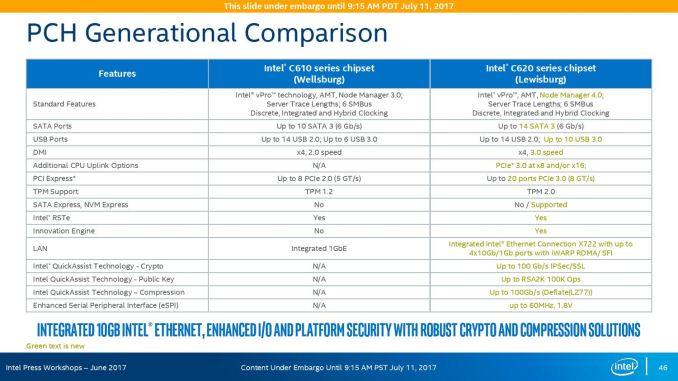
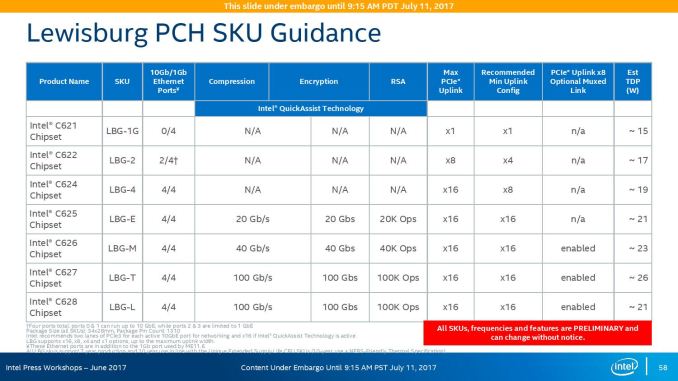
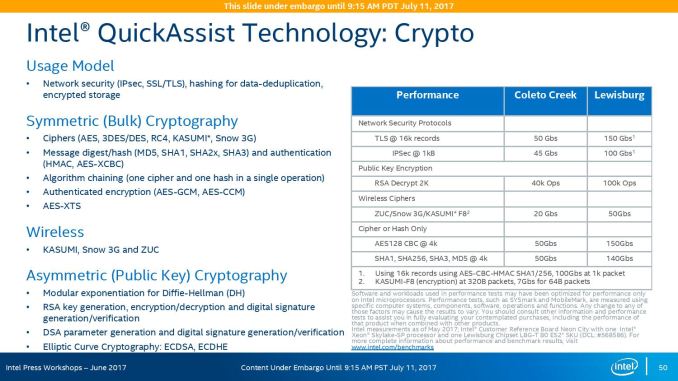

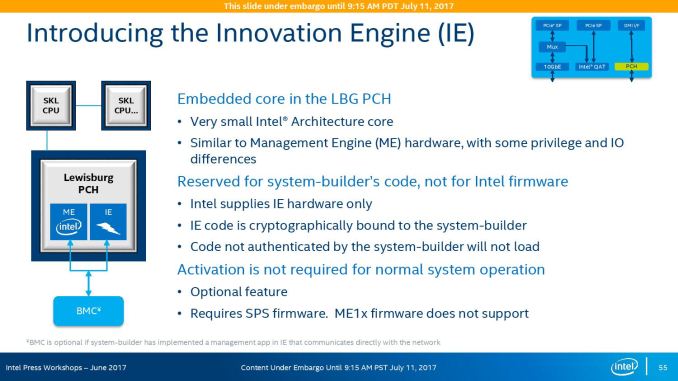
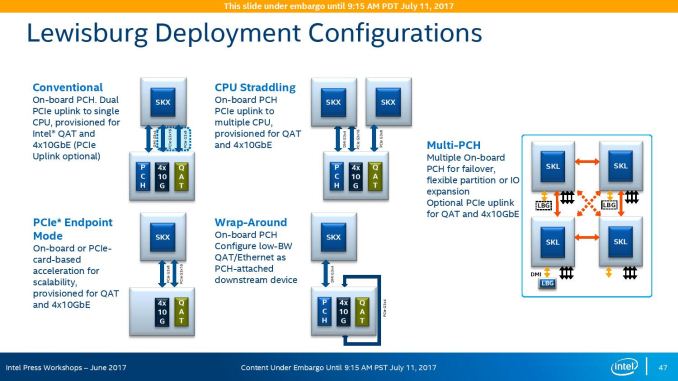








219 Comments
View All Comments
Panxa - Sunday, July 16, 2017 - link
"Competition has spoiled the naming convention Intels 14 === competetions 7 or 10"The node naming convention used to be the gate length, however that has become irrelevant. Intel 14 nm gate lenghth is about 1.5x and 10 nm about 1.8x. Companies and organizations have developed quite accurate models to asses process density with equations based on process poarameters like CPP and MPP to what they call a "standard node"
"Intel used to maintain 2 year lead now grew that to 3-4year lead"
Don't belive intel propaganda. Intel takes the lead in 2014 with their 14nm process with a standard node value of 12.1. Samsung and then TSMC take the lead in 2017 with their 10nm processes having standard node values of 11.2 and 10.3 respectively. Intel will retake the the lead back when they deliver their 10nm process with a standard node value of 8.3. However it will be a short lived lead, TSMC will retake the lead back with their 7nm with a standard node of 7.9 before GLOBALFOUNDRIES takes the lead in 2018 with their 7nm process with a standard node value of 7.8. The gap is gone !!!
"yet their revenue profits grow year over year"
Wrong. Intel revenue for the last years remained fairly constant
2011 grow
2012 decline
2013 decline
2014 grow
2015 decline
2016 grow
All in all from 2011 to 2016 revenue went from 54 billion to 59 billion. If we take into account inflation $54 billion in the year 2011 is worth $58.70 billion today.
Not to mention that Samsung has overtaken Intel to become the world No.1 semiconductor company, and that a "pure play" foundry like TSMC has surpassed intel in market CAP
johnp_ - Wednesday, July 12, 2017 - link
The Xeon Bronze Table on Page 7 seems to have an error. It lists the 4112 as having 5.50MB L3, but ark says it has 8.25MB, just like the 3104, so it looks like it has an above-average L3/Core:https://ark.intel.com/products/123551
Ian Cutress - Friday, July 14, 2017 - link
I've got Intel documents from our briefings that say it has the regular 1.375MB/core allocation, and others saying it has 8.25MB. I'm double checking.johnp_ - Friday, July 21, 2017 - link
All commercial listings and most reviews I've seen online show the processor with 8.25MB as well.Do you have any further information from Intel?
pepoluan - Wednesday, July 12, 2017 - link
What I'm dying to know: Performance when running as virtualization host. Using Xen, VMware, and Hyper-V.Threska - Saturday, July 22, 2017 - link
Virtualization itself, and more importantly virtualization security.Sparkyman215 - Wednesday, July 12, 2017 - link
Typo here: Intel will seven different versions of the chipset, varying in 10G and QAT support, but also varying in TDP:tmbm50 - Wednesday, July 12, 2017 - link
One thing to consider when considering value is the Microsoft Server 2016 core tax.....assuming your mission critical apps are still tied to MS ;-)Server 2016 now chargers per core with an 8 core socket as the base. The Window license for a 32 core server is NUTS.
I'm surprised AMD and Intel are not pushing Microsoft on this. For datacenters like ourselves its pushing us to 8 core sku's with more 2U nodes.
msroadkill612 - Wednesday, July 12, 2017 - link
Aye, its a fuuny world lad.The way the automobile panned out differently in different countries, was laargely die to fuel tax regimes, rather than technology.
i.e. what is the best way to cheat a bit on the incumbent tax rules of germany/france/uk vs a more laissez faire USA. In UK, u were taxed on horsepower, but u could cheat a bit w/ hi revs & more gears - that sort of thing.
rahvin - Wednesday, July 12, 2017 - link
Who runs any Windows service on bare metal these days? If you haven't virtulalized your windows servers running on KVM you should.